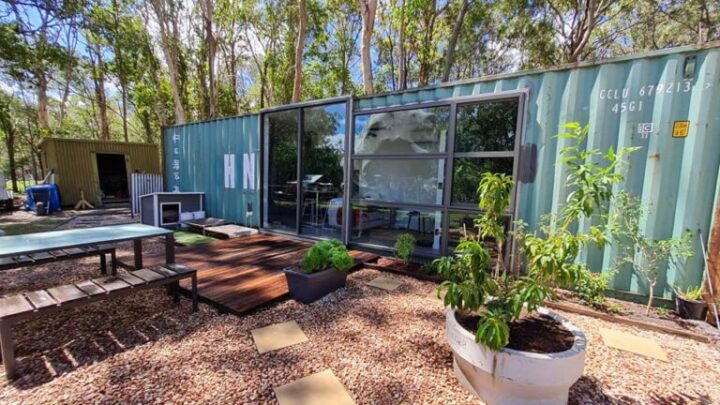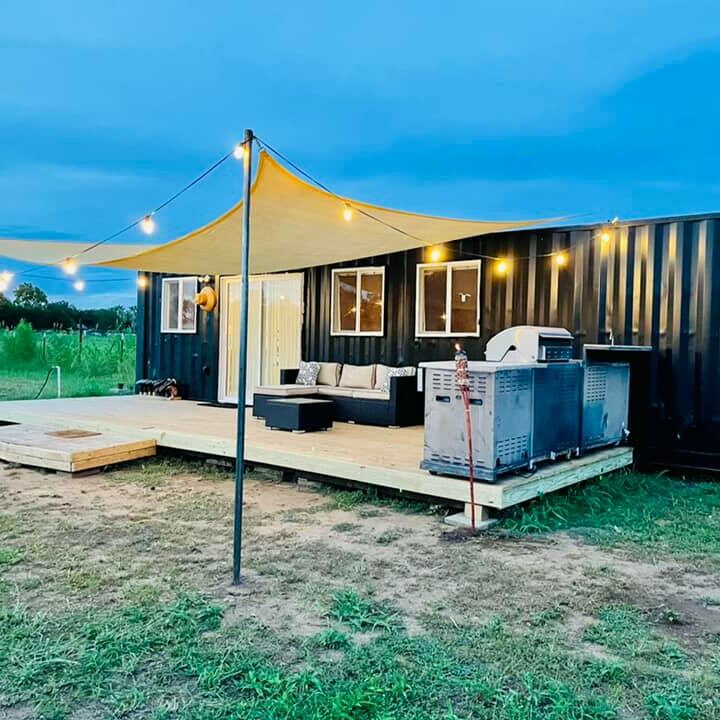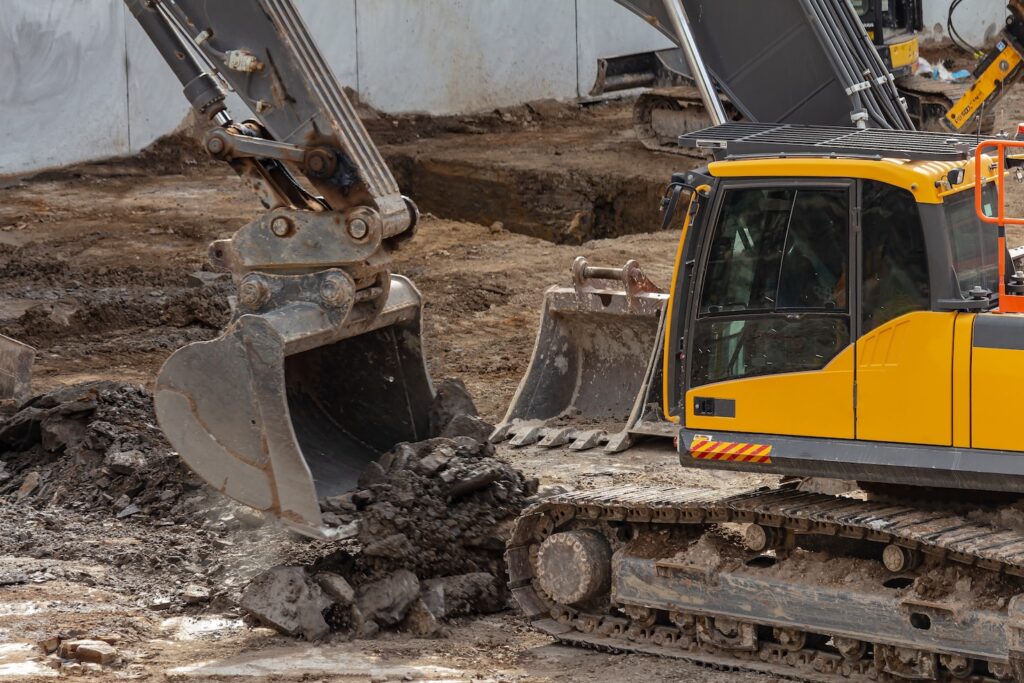Are you interested in building a shipping container home with a basement? In this article, we will provide you with expert tips on how to make this unique combination a reality.
If you’re looking to take your shipping container home to the next level, incorporating a basement can greatly enhance its functionality and maximum space.
Building a basement beneath your container home comes with several advantages, and we will guide you through the process of creating a basement that perfectly complements your container home.
With the right planning and expert tips, you can successfully create a stunning and functional space that meets all your needs.
So, if you’re ready to embark on this exciting build, keep reading to discover how to bring your dream home to life.

Key Takeaways
- If you’re thinking about building a shipping container home with a basement, it can offer you some great benefits.
- One of the main advantages of building a shipping container home with a basement is the extra space it provides.
- Constructing a concrete basement can ensure the stability and structural integrity of your home.
- A basement can also enhance the durability of your shipping container home. The concrete walls of the basement provide added protection against external elements like extreme weather conditions or pests.
- The concrete walls of the basement act as a thermal barrier, regulating the temperature inside your home. This can lead to energy savings and a more comfortable living environment.
- While burying a shipping container as a basement is an option, constructing a concrete basement is generally considered the best approach.
- To successfully build a shipping container home with a basement, careful planning and execution are crucial. Consult with experts who have experience in this type of construction.

Can You Put a Basement Under a Shipping Container Home?
If you’re wondering if it’s possible to put a basement on your shipping container home, then the answer is simply yes, it’s possible.
The size and structural beams required will be the only variations when building a shipping container home with a basement.
Make sure to obtain permission from local authorities before starting the construction process. This is necessary to ensure compliance with zoning regulations and to avoid any interference with underground utility systems.
Considerations must be made for ventilation, electrical supply connections, and potential plumbing arrangements.
Building a shipping container home with a basement offers unique challenges and considerations. However, with proper planning, professional guidance, and adherence to local regulations, you can create a beautiful and functional living space that meets your needs and preferences.
Advantages of a Shipping Container With Basement
Building a shipping container home with a basement offers several advantages. Let’s explore them one by one.
Gain Extra Storage and Add Value
Adding a basement to your shipping container home can give you extra storage and increase its value.
With a basement, you can make the most of your living space by keeping your belongings organized and out of sight.
Utilizing the space underneath your container home can double your floor space and create a dedicated storage area. This is especially useful for items you don’t use every day or want to keep securely stored away.
Whether you need additional bedrooms, a home office, or a recreational area, a basement can offer you the flexibility to meet your needs.
Not only does a basement provide practical storage solutions, but it also adds value to your container home. Potential buyers are likely to find the extra space appealing.
Expand a Property on a Restricted Plot
Upgrading to a shipping container home with a basement is a great option for increasing living space without expanding outward.
This is especially beneficial for small plots, close neighbor proximity, or for those who prefer to maintain their property’s exterior as is.
To meet safety regulations, insulation and adjustments to the basement depth are necessary to ensure the top section is above ground level and escape windows can be installed. These windows not only provide light and ventilation but are also legal requirements.
Protect Your Home Against Extreme Weather Conditions
Protecting your home from extreme weather conditions is crucial. One effective way to achieve this is by incorporating a shipping container with a basement.
Burying the container and using it as a basement can help you create a strong foundation that offers enhanced resistance to strong winds, hurricanes, and tornadoes.
Shipping container foundations differ in types, such as piers, beams, and concrete slabs. However, the latter options are not very effective in protecting against uplift during severe weather conditions like hurricanes and tornadoes.
Above-ground slabs are susceptible to frost heave in cold climates, necessitating a deeper concrete footing. Typically, these strong foundations are placed approximately 4 feet below ground level.
However, by digging just 5 feet further, one could create a shipping container home with a basement and an additional story.

Can you bury a shipping container in the Basement?
Burying a shipping container in the basement is possible, but it isn’t recommended. These containers, made of thin steel walls, aren’t designed to handle the weight and pressure of soil when buried.
To make it possible, extensive modifications would be needed to reinforce the container’s structure. Plus, layers of waterproofing would have to be applied to prevent rust and moisture damage.
Instead of burying a container, a better option for building a shipping container home with a basement is to construct a concrete or stone foundation.
This foundation offers stability and prevents sinking, ensuring that the container remains level and secure. Consult with structural engineers to comply with building codes and address concerns regarding underground construction, such as the frost line, backfilled soil, and ventilation.

How to Build a Basement for a Container Home
While constructing a basement for a traditional home may differ from building one for a container home, the process can be accomplished with careful planning and consideration.
Here are some steps you can follow:
Obtain Permits
Check with your local building department to obtain the necessary permits and permissions for constructing a basement.
It is usually required to submit detailed plans and specifications for the container home project to the local building department.
This documentation should include information on the foundation, footings, electrical systems, plumbing, and other structural elements.
The building department will review these plans to ensure compliance with building codes and regulations.
Design and Planning
Designing and planning the basement for your container home requires careful consideration and consultation with professionals.
The type of foundation you choose for your basement will depend on factors like soil conditions, climate, and the overall design of your container house.
You’ll need to determine the square footage of the basement based on your needs and the available space. You can opt to construct the basement below ground level or at the same level as the top of the container.
Excavation
It’s recommended to hire an experienced excavation contractor who understands the necessary dimensions and depth requirements.
Plan the dimensions based on the size of your container home and determine the desired depth, considering factors like intended use, building codes, and soil conditions.
Discuss proper drainage and incorporate waterproofing measures to keep the basement dry. Work closely with professionals to ensure a stable and appropriately sized hole for your basement.

Foundation
The foundation supports the weight of the containers and the entire home. To create a sturdy foundation, you can use materials like concrete or reinforced concrete footings. These materials are suitable for withstanding heavy loads.
Concrete is the most commonly used building material for foundations. It’s durable and capable of withstanding the weight of the containers.
The footings should be carefully designed and constructed to distribute the load evenly and ensure the structural integrity of the container.
This foundation work is crucial for providing long-term stability and preventing any potential settling or shifting of the structure.
Waterproofing and Insulation
Waterproofing and insulation of the basement in a container home are crucial to protecting the structure from water damage and maintaining comfortable living conditions.
The basement walls should be properly sealed and waterproofed to prevent moisture penetration. This can involve applying a waterproof coating or membrane to the walls and ensuring proper drainage systems are in place.
Insulating the basement walls helps regulate temperature and prevent heat loss or gain. This can be achieved through the installation of insulation materials such as spray foam, rigid foam boards, or batt insulation.
Proper waterproofing and insulation in the basement of a container home will contribute to the overall durability, energy efficiency, and comfort of the living space.
Framing and Finishing
Creating a basement for your container home involves framing walls and partitions using wooden or steel studs.
This step allows you to divide the space into separate rooms or sections, making it more functional and organized.
Don’t forget to install plumbing lines for water supply, drainage, and sewage, as well as electrical wiring and outlets, to ensure your basement meets your needs.
Consider the structural integrity of your container home when framing the walls. The weight of the soil surrounding the basement can potentially weaken the structure, so reinforcing it properly is crucial.
Incorporating ventilation into your basement design is essential to prevent moisture buildup and maintain a healthy living environment.
Once the framing is complete, it’s time to finish the walls. You can use drywall or other materials of your choice to achieve the desired look.
Install flooring, lighting fixtures, and any other finishing touches that align with your design preferences.
The Best Method: Constructing a Concrete Basement
One of the best methods for constructing a shipping container home with a basement is to opt for a classic concrete basement.
Although this may seem like an obvious choice, it is often disregarded for more traditional structures.
However, basements made of cement can be customized to fit the desired dimensions and offer a sturdy and functional foundation for container homes.
To ensure maximum stability, piers can be installed in the corners to securely attach the containers.
While it may be slightly more costly initially, choosing this approach guarantees the safest and most long-lasting installation of a basement beneath a shipping container home.
Don’t forget to reinforce the walls with steel rebar before pouring the concrete. This step is vital to ensuring the structural stability of your basement.
Final Thoughts
Are you considering building a shipping container home with a basement? This can be a great option for those looking for extra space, increased durability, and improved insulation.
While burying a shipping container as a basement is possible, constructing a concrete basement is generally considered the best approach.
With the right expert tips and construction techniques, you can create a functional and secure basement that seamlessly integrates with your shipping container home.
For more tips about container homes, feel free to visit our guides here.

